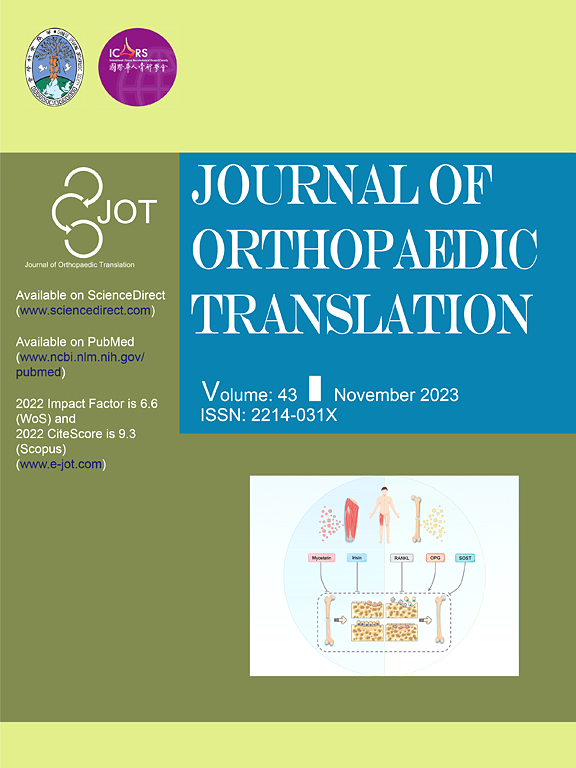原发性全髋关节置换术后十年以上出现的慢性扩张性血肿
IF 5.9
1区 医学
Q1 ORTHOPEDICS
引用次数: 0
摘要
背景:慢性扩张性血肿(CEH)是全髋关节置换术(THA)后罕见但严重的并发症。对这种情况处理不当会导致严重的后果。本研究的目的是对我院过去20年来THA后发生CEH的患者进行回顾性分析,并对现有文献进行综述。这种全面的方法旨在为CEH的诊断和治疗提供有价值的临床见解。方法:在本研究中,我们对在过去20年内接受过THA并在随访期间发展为CEH的患者进行了回顾性研究。收集的数据包括基本的患者人口统计数据,包括年龄、性别和有关原发性THA植入物的具体情况。此外,我们收集了术前、术后和随访的影像学研究。在数据汇编之后,我们进行了全面的文献综述,以汇总和分析已发表的tha后发生CEH的病例。结果我们的随访数据确定了5例在THA术后10年以上发生CEH的患者。1例CEH表现为创伤性事件,其余4例为非创伤性事件。翻修手术后的结果是不同的:两名患者在至少一年的随访期间没有复发迹象,一名患者最终截肢,两名患者发生假体周围关节感染(PJI),这是一个持续的管理挑战。我们的文献回顾显示了先前报道的9例具有相似临床特征的病例。病因学:虽然通常与创伤或手术有关,但并不总是存在明确的原因。据推测,在初始过程中不充分的止血可能有助于CEH的发展。时间过程:这种情况通常在一段较长的时间内缓慢发展。发病机制:发病机制尚不清楚。诊断:MRI: t2加权序列显示低信号和高信号的结合,反映新鲜血液和旧血液的混合,提示复发性出血。t1加权序列信号等强或稍高。组织学特征:以三个不同的方面为特征:外周壁被纤维组织紧密包裹;新鲜和流动的血凝块;以及疏松结缔组织形成的中心区域。鉴别诊断:包括炎性假瘤、血友病、恶性肿瘤等。治疗:护理的金标准包括完全的手术切除,包括包膜。考虑到CEH的进行性骨吸收倾向,建议一旦确诊,患者每2-3个月定期随访一次。如果发现明显的骨质流失,应考虑手术切除肿块。结论:ceh是THA后出现的罕见并发症,通常在数年内缓慢发展。考虑到如果处理不当可能造成毁灭性后果,警惕的后续护理至关重要,以确保在发现CEH后及时发现和立即治疗。本研究提高了诊断准确性,优化了治疗,改善了预后,降低了医疗费用,并促进了THA后罕见疾病CEH指南的更新。本文章由计算机程序翻译,如有差异,请以英文原文为准。

Chronic expanding hematomas arising over a decade post primary total hip arthroplasty
Background
Chronic expanding hematoma (CEH) is an infrequent yet serious complication following total hip arthroplasty (THA). Mismanagement of this condition can result in severe consequences. The purpose of this study is to conduct a retrospective analysis of patients who developed CEH after THA at our institution over the past 20 years, complemented by a review of the existing literature. This comprehensive approach aims to contribute valuable clinical insights into the diagnosis and management of CEH.
Methods
In this study, we conducted a retrospective study of patients who had undergone THA within the past two decades and subsequently developed CEH during their follow-up period at our institution. The data collected encompassed fundamental patient demographics, including age, gender, and specifics regarding the primary THA implants. Additionally, we gathered preoperative, postoperative, and follow-up imaging studies. Following the data compilation, a thorough literature review was performed to aggregate and analyze the published cases of CEH occurring post-THA.
Results
Our follow-up data identified five patients who developed CEH more than ten years after undergoing THA. In one case, CEH manifested subsequent to a traumatic event, while the remaining four cases were non-traumatic. The outcomes following revision surgery were heterogeneous: two patients showed no indications of recurrence throughout a least follow-up period of over one year, one patient eventually underwent amputation, and two patients developed periprosthetic joint infection (PJI), an ongoing management challenge. Our literature review revealed nine previously reported cases with similar clinical features. A summary is as follows: Etiology: While often linked to trauma or surgery, a definitive cause is not always present. It is hypothesized that inadequate hemostasis during the initial procedure may contribute to the development of CEH. Time Course: The condition typically evolves slowly over an extended period of years. Mechanism: The underlying mechanism remains unclear. Diagnosis: MRI: T2-weighted sequences exhibits a combination of hypointense and hyperintense signals reflecting a blend of fresh and old blood, indicative of recurrent hemorrhage. Isointense or slightly high signals on T1-weighted sequences. Histological Features: Characterized by three distinct aspects: a peripheral wall densely encapsulated in fibrous tissue; fresh and mobile blood clots; and a central zone of loose connective tissue formation. Differential Diagnosis: Includes inflammatory pseudotumors, hemophilia, and malignant neoplasms, among others. Treatment: The gold standard of care involves complete surgical resection, inclusive of the capsule. Given CEH's propensity for progressive bone resorption, it is recommended that once identified, patients undergo regular follow-ups every 2–3 months. Should significantly bone loss be detected, surgical excision of the mass should be contemplated.
Conclusion
CEH is a rare complication that can arise following THA, typically exhibiting a slow progression over a period of years. Given the potential for devastating consequences if mishandled, vigilant follow-up care is essential to ensure timely identification and immediate treatment of CEH upon detection.
The translational potential of this article
This study enhances diagnostic accuracy, optimizes treatment, improves prognosis, reduces medical costs, and promotes the update of guidelines for the rare disease CEH after THA.
求助全文
通过发布文献求助,成功后即可免费获取论文全文。
去求助
来源期刊

Journal of Orthopaedic Translation
Medicine-Orthopedics and Sports Medicine
CiteScore
11.80
自引率
13.60%
发文量
91
审稿时长
29 days
期刊介绍:
The Journal of Orthopaedic Translation (JOT) is the official peer-reviewed, open access journal of the Chinese Speaking Orthopaedic Society (CSOS) and the International Chinese Musculoskeletal Research Society (ICMRS). It is published quarterly, in January, April, July and October, by Elsevier.
 求助内容:
求助内容: 应助结果提醒方式:
应助结果提醒方式:


